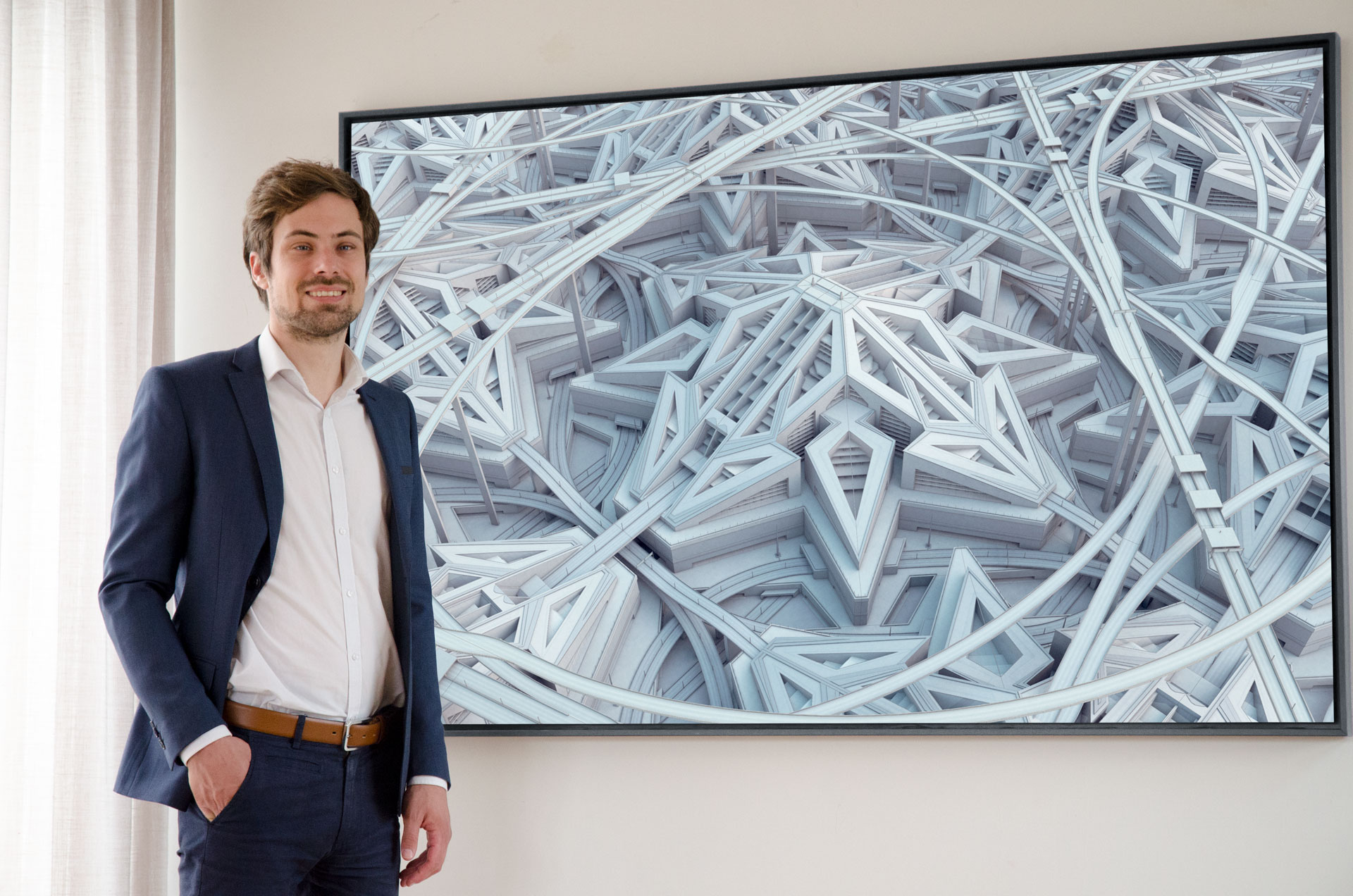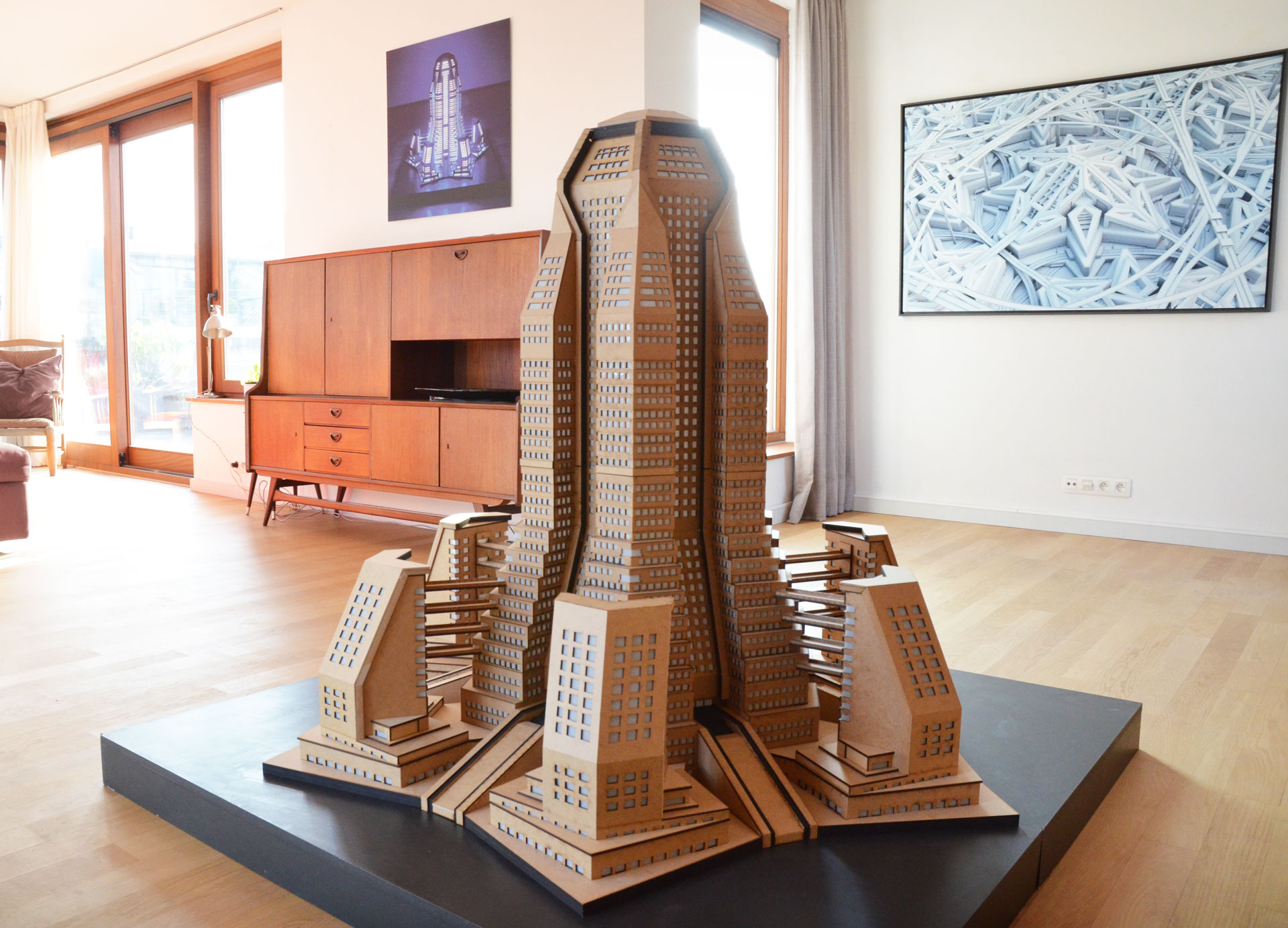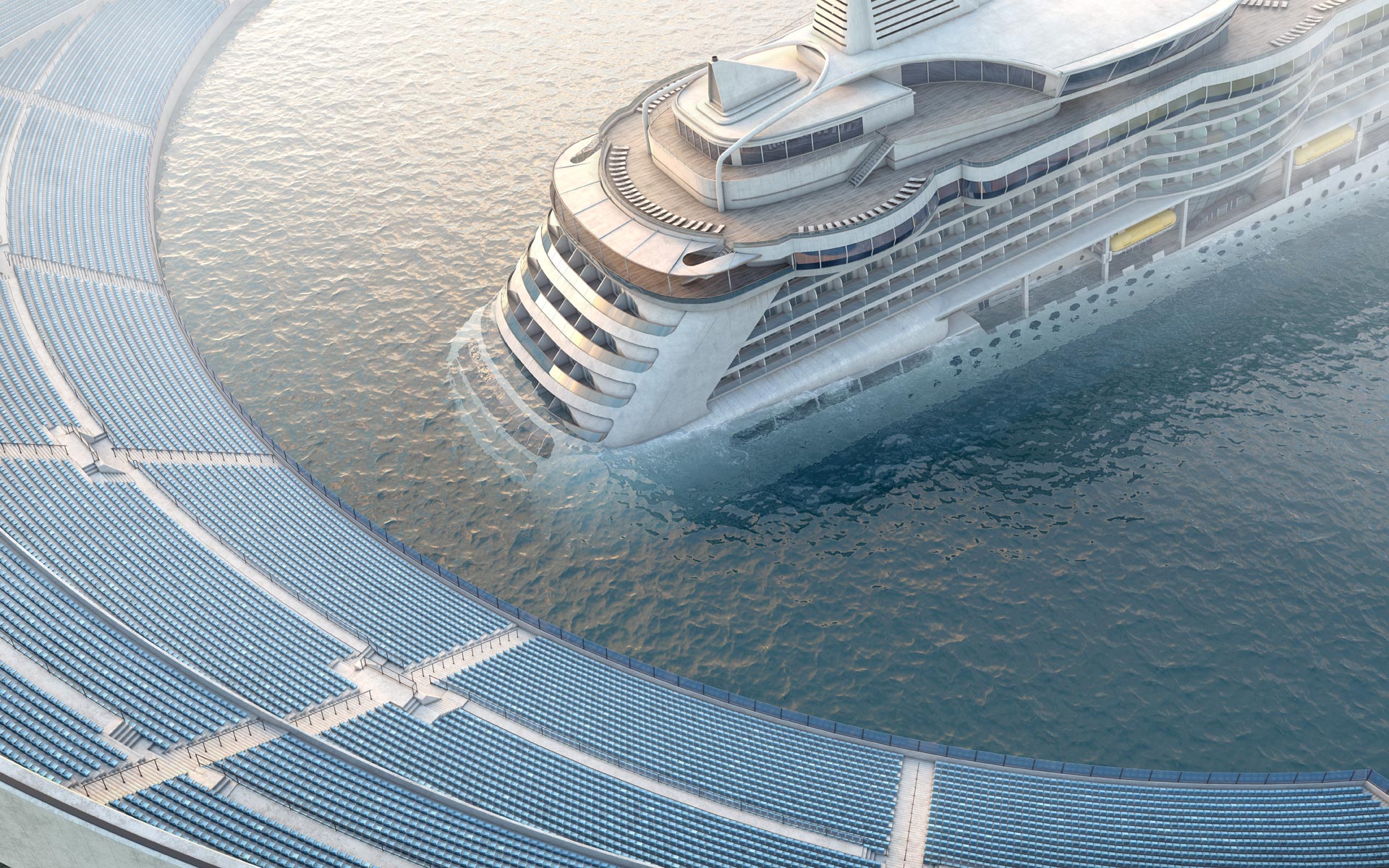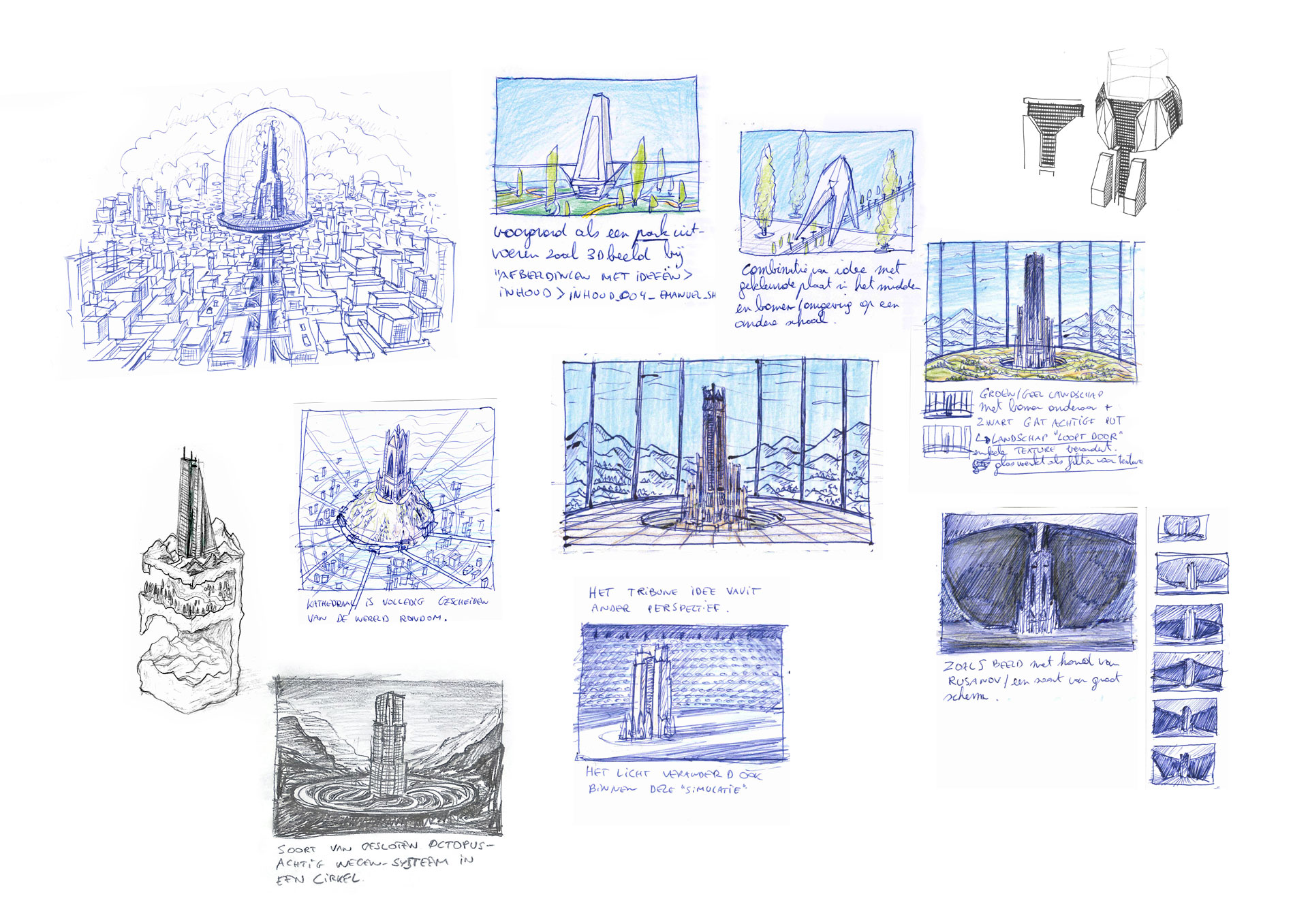Artist Statement
Pieter Léon Vermeersch (°1984) is a Belgian artist living and working in Vilvoorde. His work deals with the tension between the concepts of utopia and dystopia.
The dystopian predictions by authors like Aldous Huxley and George Orwell about worlds without privacy which are dominated by the increasing power of authoritarian regimes and/ or big companies, are becoming a reality. The concept of utopia on the other hand has been dismissed after the failures of the 20th century.
Now more than ever, there is a need for the power of the imaginative mind to see where we want to take our world and our cities. A society without a vision for the future is a society without a soul.
The buildings Pieter Léon Vermeersch designs are not real buildings. They are buildings that, by their imaginative character, make us reflect about the world. They depict architecture and the city as viewed through the lens of the artist.
“A society without a vision for the future is a society without a soul.”
Short Bio
Pieter Léon Vermeersch graduated in 2007 at the LUCA School of Arts in Brussels with the degree of Master in Visual Arts.
In 2006 he won the Michel Leën Award, granted by the Creative Club of Belgium. This is the most important award in Belgium for students who study any field related to visual communication.
After his studies Pieter started working as an independent designer and artist. In 2011 he followed a year long program in sculpture at the LUCA School of Arts to further enhance his skills.
In 2022 his work ‘Real Fiction’ was on display at the Design Museum Den Bosch in the Netherlands during their half a year long exhibition named ‘GOTH, Designing Darkness‘.
It was on display next to collections from the Musée d’Orsay in Paris, the Royal Institute of British Architects, the Kröller-Müller Museum and the Hamburger Kunsthalle, among others.
Selected Art Shows
- Anemoia – Duo Art Show by WARP at Mia-Art in the center of Antwerp, 2023
- GOTH – Designing Darkness – Design Museum Den Bosch – “Real Fiction” is on display during 6 months – Netherlands – 2022
- Orbem Novis – Morbee Gallery – Curator: Daan Rau. Trio Art Show with visual artists Pieter Léon Vermeersch, Rob Buelens and Hendrik Vermeulen. Knokke-Heist, 2021
- Ghent University, Engineer-Architects, guest lecture about my design methods. 2021
- Coup de Ville – Chasing Flowers – Sint-Niklaas by WARP and curator Stef Van Bellingen, 2020
- Participant in the Blauwhaus by Wim Wauman. Summer of 2019. Artwork on permanent display in the centre of Waasmunster, 2019
- ‘¿ A Ves… You Know!’ Group Art Show in Ljubljana, Slovenia by WARP, curated by Laureline Soubry and Stef Van Bellingen, 2019
- Solo Art Show “Beautiful Dystopia” at Aporia Gallery in Brussels – 2018
- Northwestern University, Chicago, Commissioned Artwork, 1,6 x 1 meter, permanently on display in the new ‘Global Hub’ building- 2017
- There’s always more to see – Museum M Leuven – Selected “Open M” artist. 4 artworks shown, Curated by Flor Bex – 2017
- Final Exhibition “Canvascollectie/ La Collection Rtbf 2012” at BOZAR Museum for Fine Arts in Brussels – 2012
- Final exhibion “Canvascollectie/ La Collection Rtbf 2010” at BOZAR Museum for Fine Arts in Brussels – after a selection out of more then 8000 artists – 2010
Awards and Selections
Selected Artist WARP Ljubljana, Slovenia Presentation and Art Show 2019
Selected for the international Artist Village in Eindhoven 2018
Open M selected artist M Museum Leuven 2017
Canvascollectie final selection BOZAR Center for Fine Arts Brussels 2012
Canvascollectie final selection BOZAR Center for Fine Arts Brussels 2010
Creative Club of Belgium Michel Leën Award winner 2006
About the Process
I believe that a strong concept can take a project to new heights. To develop a good concept, I look into art history and read books on various subjects, such as philosophy, history, and architecture. It’s a long process, but it’s worth it.
I jot down my ideas and make small sketches. After I’ve collected a pool of ideas, I let them have some “idea sex” – which involves combining two or more ideas into a new one. From this process, I pick out the best ones and test them out.
Once I have chosen a particular concept, I create hundreds of variations of the composition, lighting, and colors, ultimately selecting one final version.
Once I have the basic shapes, I work on adding details, which can take a lot of trial and error. It’s like painting, where I add elements and sometimes remove them later. I always keep proportion and harmony in mind.
In the first phase, I create all of my artworks on the computer, using software such as Blender, Sketchup, 3ds Max, Vray, World Machine, Illustrator, and Photoshop.
I never use generative AI software; instead, I draw each image from scratch.
I print all my artwork on a top-quality German etching paper from Hahnemühle, which is then mounted on aluminum Dibond.
It is a paper that is almost 100% matte, which ensures that there are no distracting reflections from, for example, a window or a lamp.
To enhance the piece, I also design a custom “floating frame” that surrounds the print. I believe that the frame is an integral part of the artwork itself and should be considered as such.
Why do I do what I do?
Since childhood, I have been searching for underlying structures in a world that is becoming increasingly complex. I think this is a way for me to deal with the potential dangers and uncertainties in my life.
The work that I create also attempts to provide an answer to this. I try to structure the world in a way that is understandable to me.
About my Inspiration
My main sources of inspiration are the works of other artists, books and history. If there is a general theme to my work, it would the greater concept of our society and its future and the use of geometrical patterns as a basis to create a new world.
Below are some examples of people who have been inspirational to me.
Aldous Huxley is best known for his book ‘Brave New World‘, in which he describes a future society in which people have no pain or bad feelings because of the availability of a perfect drug that puts a person in a constant happy mood.
The main character wants to escape this society because he is a misfit. After finding himself in all kinds of misadventures he kills himself at the end of the story.
The book puts into question if a life with no highs and lows is worth living.
I think that highs and lows in our mood are an essential part of our life. Feeling pain makes you want to solve the problem that causes the pain. Pain is the source of growth in that regard. And I believe that growth is one of the main sources of happiness. So a life without pain would probably be empty.
All of this makes me think about what kind of a future society we want to live in. In the West most of us have all the material goods we want, but we still have a very hard time finding fulfillment and happiness.
Antonia Sant’Elia is a key member of the Futurist movement in Italy. I think his designs are an unparalleled marvel. Even if his drawings often consist of only a few lines, he is a true master of architectural composition.
Sam Harris is an American neuroscientist and philosopher. A few of the topics he writes about are ‘Free Will’, ‘Philosophy of Mind’ and’ Artificial Intelligence’.
I think there are not many people who represent the voice of reason so eloquent. He states that problems in society are not the consequence of bad people, because people who do bad things on purpose are very rare. Instead the cause of the problems is rather bad ideas, which can be very contagious. Therefore he encourages us to have more conversation.
Arthur C. Clarke, the famous science-fiction novel writer, wrote a book in 1956 called ‘The City and the Stars’, in which he describes a city that has been in existence for 1 billion years. The city is virtual by nature and the information of its shape and content is stored in central memory banks which are managed by an artificial intelligence. The material of the city feels like real material but is actually virtual. The people live in small rooms without any visible corners which can be turned into projection walls for a virtual reality world in which they can immerse themselves. People don’t really die, they are simply reborn after a certain period of time.
By design there is one “joker” in the city who doesn’t have to follow the rules. He is allowed to act in weird ways as to not make the system too static.
The main character manages to leave the city after a long struggle and comes into contact with a tribe of people who are living a primitive life. He eventually comes to appreciate the natural way of living of this people and sees the value of possibility of death.
First I think it is just unbelievable that Arthur C. Clarke described such a city in 1956 when modern computers were still 30 years ahead in the future.
Secondly I think the story is a very interesting reflection on what life means for us in a technological society. After all we are just naked apes and we are nearing a moment where we will be able to surpass our biological limits. Will we still be human? Will it be an improvement or a decline?
I first truly discovered the richness of Arab geometric patterns in the Bou Inania Madrasa in Meknes, Morocco. This is a religious school from the 14th century.
The repeating patterns which are carved in the stone walls show an enormous variety in beautiful shapes and complexities. These patterns that inspire me to create my own patterns and to make three-dimensional worlds out of them.
We are standing on the shoulders of giants.
I think the vision from Étienne-Louis Boullée, the French visionary and architect from the 18th century, is great because he has such an imaginative mind. In his drawings he imagines a science driven vision for the future that reflects the changes that were going on in his time.
One of his designs is a gigantic library that stores all the knowledge in the world and surprisingly resembles a modern library. In another design he proposes a gigantic 150 meter tall monument for Isaac Newton who passed away 50 years earlier. In this highly original monument people can experience the universe and the newly found laws of nature inside a giant dome.

















